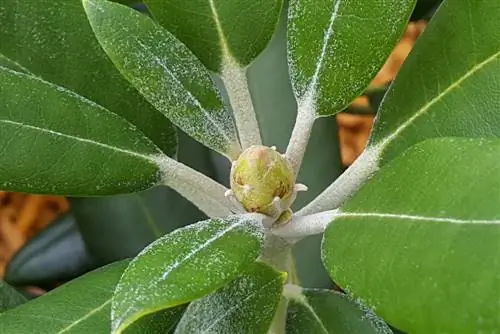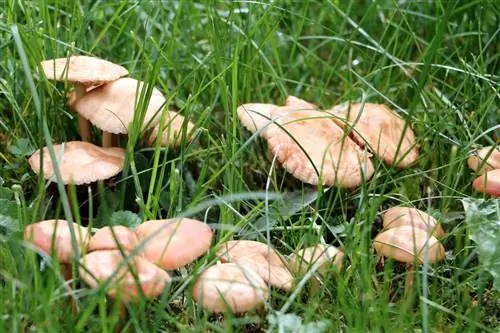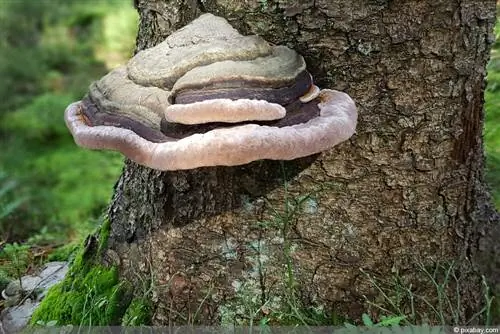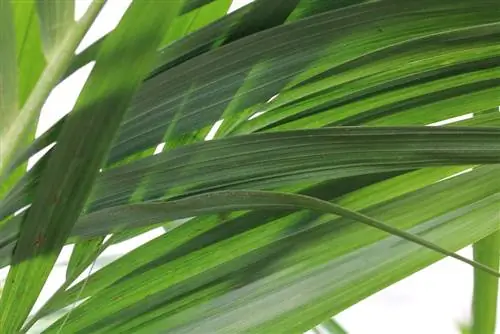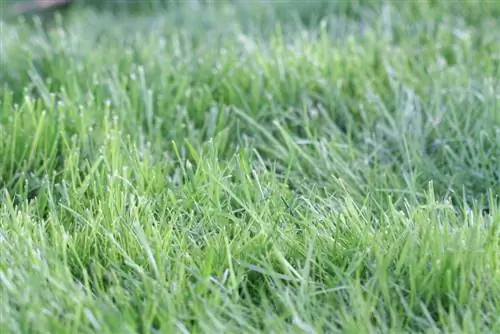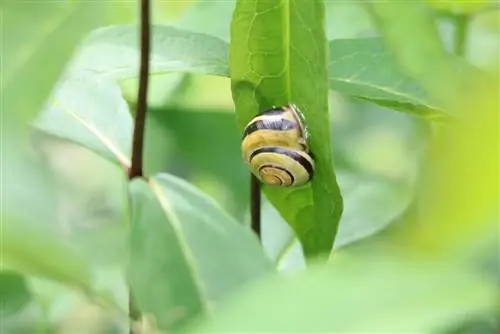- Author admin [email protected].
- Public 2023-12-17 03:39.
- Last modified 2025-01-24 12:45.
Fungi attack plants in the garden, on the terrace or balcony and they even occur on houseplants.
The most common fungi and diseases that occur in plants include:
- Mildew
- Leaf spot disease
- Star sooty dew
- Gray horse
Mildew
Mildew is the name for a whole range of fungal diseases that are caused by fungi. Today, over 100 species of powdery mildew are known, affecting more than 7,000 plants. The best known forms are powdery mildew and bottle mildew.
Powdery mildew
Powdery mildew is caused by ascomycota fungi. The pathogens include grass mildew (Blumeria graminis) and grapevine mildew (Erysiphe necator).
Damage and climatic conditions
Powdery mildew occurs predominantly on the upper side of the leaves of plants. They are covered by a gray to brown, flour-like coating. The leaves curl up and turn brown as the disease progresses, eventually drying out. Even if the fungus first attacks the leaves, it does not stop at buds, flowers and stems. Buds and flowers no longer open and ultimately whole parts of the plant wither.
Powdery mildew prefers warm and dry weather. This is why it is also called a fair-weather mushroom. But warm, humid weather is also an ideal climate for the fungus to spread. It also spreads when there are large differences in temperature, for example in autumn, when there are large temperature differences between day and night. The ideal temperature for the fungus to spread is 20 degrees Celsius.
The following are particularly susceptible to infestation:
- Asters
- Roses
- Gooseberries
- Cucumbers
Downy mildew
Oomcyta are responsible for downy mildew. The most important representatives of their kind include:
- Wine downy mildew (Plasmopara viticola)
- Blue mold of tobacco (Peronospora tabacina)
- Lettuce downy mildew (Bremia lactucae) and
- Host-specific Phytophtora species
Damage and climatic conditions
The egg fungi, i.e. the pathogens of downy mildew, penetrate deeper into the plant than powdery mildew. You can recognize an infestation by a white coating on the underside of the leaves. The damage also includes yellow-purple to brown spots on the top of the leaves. As the disease progresses, it spreads to stems and flowers. If the fungus is not controlled, the infection leads to the death of the plant. Particularly threatened plants are:
- Onions
- Cabbages
- Salad
- Roses
- Sunflowers
Unlike powdery mildew, downy mildew loves damp weather. It often occurs in glasshouse cultures.
Combating mildew
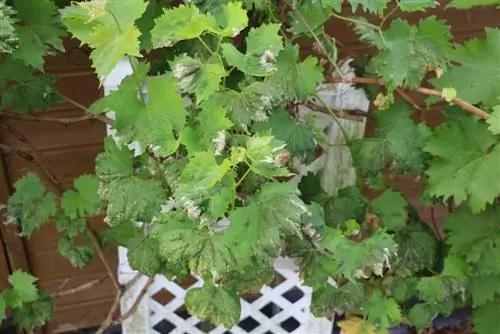
Mildew is a stubborn fungal disease, but there are various natural ways to stop the infestation. These include:
- Plant broths made from horsetail, tansy or garlic
- Sprays made from milk and whey
- Beneficial insects such as ladybirds or sawflies
For the horsetail plant broth, soak one kilogram of fresh or 350 grams of dried field horsetail in ten liters of water for 24 hours. After the exposure time, the resulting broth is boiled for around 30 minutes. Then strain the broth. For pouring, the broth must be diluted with five times the amount of water.
For the cow's milk spray you need fresh, untreated cow's milk. It is diluted with water in a ratio of 1:8. This solution can be used to spray endangered plants from April to July.
Tip:
Low temperatures are not a solution to the infestation. The fungus can survive the winter in the soil or on the plant. As soon as the plant sprouts again in spring, the fungus appears again.
The conditions can also be changed as a preventive measure so that the fungus does not even settle. Therefore, ensure light and air between the plants. Various herbs also have a preventative effect and make life difficult for the fungus. These include:
- Basil
- Chives
- garlic
Leaf spot disease
Leaf spot, as the name suggests, causes spots on the leaves of plants. The appearance of the spots can vary. They can be brown, red or yellow in color, the size of the spots also varies. A brighter spot can often be seen in the center of the spot. This is the location of the fruiting body of the fungus. As the disease progresses, a hole forms in the leaf, which causes the leaf to dry out and fall off.
Climatic conditions
As with other fungal diseases, certain conditions favor the infestation.
- Too small a distance between the plants
- Lack of light
- Nutrient Deficiency
- Incorrect fertilization
- Sunburn

Therefore, ensure there is enough space between the plants. This way they get enough light. Since the fungus mainly appears in dry periods, the plants only water from below. Avoid wetting the leaves with the irrigation water.
Combat
In addition to preventative measures, home remedies also help against the fungus.
- Coffee grounds
- Egg cooking water
- Banana peels
- horn remains
For the fight to be successful, all affected parts of the plant must be generously cut off. The affected plant should also be isolated. If the fungus has already spread over a large area on the plant, it unfortunately has to be destroyed.
Tip:
Unfortunately, natural and organic remedies do not help with leaf spot disease as efficiently. In the event of an infestation, you have to resort to broad-spectrum chemical fungicides.
Star sooty dew
Star sooty mold or black spot disease (Diplocarpon rosae) is caused by ascomycetes. The fungus is considered extremely stubborn and is difficult to combat.
malicious image
Star sooty dew can be recognized by round, black-brown spots that initially spread out in a star shape. As a result, the leaves turn yellow and eventually fall off. At the beginning of the disease, the lower leaves of the plant are usually affected because there is less light in the lower part of the plant. The leaves there also dry more poorly, which also promotes infestation. Star sooty's favorite plants include:
- Roses
- Laurel
Unlike many other fungi, whose spores are transmitted by wind or insects, the spores of star sooty are found in the soil. There they even survive the winter, protected.
Combat
It is difficult to control infected plants. Therefore, fungal infestation should be prevented. Since the spores of the fungus hide in the soil, you should start taking preventive measures in spring.
- Leave enough space between plants
- Avoid lack of light
- Water plants only from below
- Increase plant resistance
- Hosting down the plants, especially roses, with horsetail tea
Other preventative measures include watering with fermented nettle manure and sprinkling the ground with beech wood ash.
If the infestation with black mold has begun, the plant must be quarantined. Furthermore, all affected parts must be removed immediately.
Tip:
Do not put the cut parts of the plant in the compost. The fungus can spread further there.
To save the plant, it must be sprayed with special agents. Unfortunately, only the chemical club helps here.
Gray horse
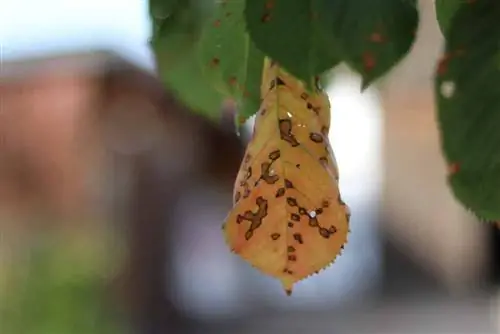
Grey mold, Latin Botrytis cinerea, is also one of the widespread fungal diseases. As with star sooty mold, ascomycete fungi are also responsible for the infestation.
Damage and climatic conditions
Gray mold appears in the form of brown spots on leaves, flowers and fruits, which quickly begin to rot when infected. Later, all parts of the plant become covered with a gray and furry coating. The fungus does not stop at woody shoots. If it is not discovered and combated in time, the disease can lead to the death of the plant. And even then you can't get rid of the fungus because it survives in the soil and the dead plant remains. If the climate is favorable for the fungus again, it emerges and the plague starts again.
Tip:
Grey mold can also survive in the soil for several years. Therefore, in the event of an infestation, the soil must also be disposed of.
As far as climatic conditions are concerned, the fungus prefers a warm, humid climate. Unfortunately, gray mold affects almost all plants. His favorite plants include herbaceous plants. It can also attack flower bulbs. Other threatened plants include:
- Geraniums
- Gladiolus
- Lilies
- Tulips
- Hyacinths
- Snowdrops
- Roses
- Raspberries
- Sunflowers
Tip:
Apart from the plant variety, gray mold tends to attack weakened plants because they have less resistance.
Combat
The best way to combat gray mold is with preventive measures. Make sure that there are no conditions favorable for the fungus. Prevention includes:
- sufficient plant spacing
- good ventilation
- no over-fertilization with nitrogen
- Don't let water get on the leaves
Tip:
Always water plants in the morning. This way they can dry off during the day.
Once gray mold has discovered the plant, it is very difficult to get rid of the fungus. Since it spreads very quickly to neighboring plants, you should not wait too long to combat it. Successful control is usually only possible if the infestation is noticed and combated early:
- generous cutting off of the affected plant parts
- Isolate plant
- Treat plants with special products
Tip:
Dispose of cut plant parts in household waste. If they are added to the compost, it can happen that the fungus is spread throughout the garden when the compost is put out.
Conclusion
Mushrooms are among the most annoying pests. Often the cause of the illness cannot be determined, but the damage caused is even greater. Since there are few effective home remedies against the infestation, preventive measures should be taken above all. If a plant is still infected, the fungus must be identified so that the correct control agents can be used.

